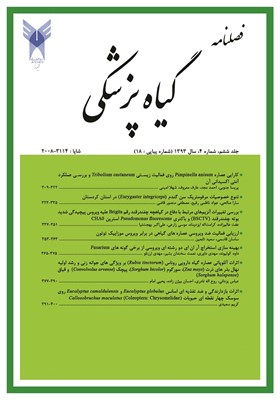Optimization of double strand RNA extraction from some isolates of Fusarium sp.
Subject Areas : Plant ProtectionDavoud KOOLIVAND 1 * , Mahdi DAVARI 2 , Nemat SOKHANDAN BASHIR 3 , Mahdi ARZANLOU 4
1 -
2 -
3 -
4 -
Keywords:
Abstract :
The majority of viruses infected fungi which have been reported contain double-strand RNA (dsRNA) genomes. Mycoviruses are introducing as agent of the biological control of fungi according to hypersensitive properties. In this research, eight isolates belong to Fusariumgenus include ofF. graminearum, F. culmorum, F. tricinctum, F. proliferatum and F. incarnatum survived to dsRNA infection. Due to using of hazardous material such as phenol and complicated procedure in different dsRNA extraction protocols in mentioned research phenol and chlorophorm was removed , using less tissue and dsRNA extraction time was reduced compared to other methods. Result showed that four isolates infected by dsRNA also, mentioned method has sufficient efficiency and convenient for dsRNA extraction from fungi tissue. Also, dsRNA was reported fromF. incarnatum (F. semitectum) for first time.
Aminian, P., Alizadeh, A., Saidi A. & Safaei N. 2011. Effect of double-stranded RNAs on virulence and deoxynivalenol production of Fusarium graminearum isolates. Journal of Plant Protection Research, 51: 29-37
Balijja, A. Kvarnheden, A. & Turchetti, T. 2008. A non-phenol-chloroform of double-stranded RNA from plant and fungal tissues. Journal of Virological Methods, 152: 32-37
Bottalico, A. & Perrone, G., 2002. Toxigenic Fusarium speces and mycotoxins associated with head blight in small-grain cereals in Europe. European Journal of Plant Pathology, 108: 611-624
Chu, Y. M., Jeon, J. J., Yea, S. J., Kim, Y. H., Yun, S. H., Lee, Y. W. & Kim, K. H. 2002. Double-stranded RNA mycovirus from Fusarium graminearum. Applied and Environmental Microbiology, 68: 2529-2534.
Chu, Y. M., Lim, W. S., Yea, S. J., Cho, J. D., Lee, Y. W., & Kim, K. H. 2004. Complexity of dsRNA mycovirus isolated from Fusarium graminearum. Virus Genes, 28: 135-143.
Compel, P., Papp, I., Bibo, M., Fekete, C. & Hornok, L. 1999. Genetic interrelationships and genome organization of double-stranded RNA elements of Fusarium poae. Virus Genes, 18: 49-56.
Davari, M., Wei, S. H., Babai-Ahari, A. Arzanlou, M., Waalwijk, C, van der Lee, T. A. J., Zare, R., Gerrits van den Ende, A. H. G., de Hoog, S. G. & van Diepeningen, A. D. 2012. Geographic differences in trichothecene chemotypes of Fusarium graminearum in the Northwest and North of Iran. World Mycotoxin Journal, 6(2): 137-150.
Davari, M., Babai-Ahari, A., Arzanlou, M., Zare, R., de Hoog, G. S. and van Diepeningen, A. D., 2014. Morphological and molecular characterization of three new Fusarium species associated with inflorescence of wild grasses for Iran. Rostaniha, 14(2): 124-134.
De´lye, C. & Corio-Costet, M. F. 1998. Origin of primary infections of grape by Uncinula necator: RAPD analysis discriminates two biotypes. Mycological Research, 102: 283–288
Fekete, C., Giczey, G., Papp, I., Szabo, L., & Hornok. L. 1995. High-frequency occurrence of virus-like particles with double-stranded RNA genome in Fusarium poae. FEMS Microbiology Letters, 131: 295-299.
Gorscak, J. J., Ayres, B. D., Bhagat, N., Hammersmith, K. M., Rapuano, C.J., Cohen, E. J., Burday, M., Mirani, N., Jungkind, D. & Chu, D. S. 2007. An outbreak of Fusarium keratitis associated with contact lens use in the Northeastern United States. Cornea, 26: 1187–1194.
Gupta S. 1991. Newer evidence to demonstrate mycovirus of Fusarium moniliform var .subglutinans as causal agent of mango shoot malformation. Journal of the Entomological Research Society, 15 (3): 222–228
Hashemi, M., Mozafari J., Ali Zadeh, A. & Shamsbakhsh, M. 2004. dsRNAs associated with Fusarium graminearum isolates in iran. Iranian Journal of Plant Pathology, 40:313-326.
Heaton, L. A. & Leslie, J. F. 2004. Double-stranded RNAs associated with Fusarium proliferatum mitochondria. Mycological Progress, 3: 193-198
Kilic, O. & Griffin, G. J. 1998. Effect of dsRNA-containing and dsRNA-free hypovirulent isolates of Fusarium oxysporum on severity of Fusarium seedling disease of soybean in naturally infested soil. Plant and Soil, 201:125-135
Kwon, S. J. 1., Lim, W. S., Park, S. H., Park, M. R. & Kim, K. H. 2007. Molecular characterization of a dsRNA mycovirus, Fusarium graminearum virus-DK21, which is phylogenetically related to hypoviruses but has a genome organization and gene expression strategy resembling those of plant potex-like viruses. Molecular Cells, 23:304-315
King, A., Lefkowitz, E., Adams, M. J. 2012. Virus Taxonomy: Ninth Report of the International Committee on Taxonomy of Viruses. Academic Press, London, UK. 1327 pp.
Leslie, J. F. & Summerell, B. A. 2006. The Fusarium Laboratory Manual. Blackwell Publishing.
Morris, T. J. & Dodds, J. A. 1979. Isolation and analysis of double-stranded RNA from virus-infected plant and fungal tissue. Phytopathology, 69: 854-858
Nogawa, M., Nakatani, A., Gonda, K., Shimosaka, M. & Okazaki. M. 1996. Replication of double-stranded RNA in mycovirus from the plant pathogenic fungus, Fusarium solani. FEMS Microbiology Letters, 137: 45-49
Pearson, M. N., Beever, R. E., Boine, B. & Arthur, K. 2009. Mycovirus of filamentous fungi and their relevance to plant pathology. Molecular Plant Pathology, 10:115-128.
Refos, J. M., Vonk, A. G., Eadie, K., Lo-Ten-Foe, J. R., Verbrugh, H. A., van Diepeningen, A. D. & van de Sande, W. W. J. 2013. Double-Stranded RNA Mycovirus Infection of Aspergillus fumigatus is Not Dependent on the Genetic Make-Up of the Host. PLoS ONE, 8(10): e77381
Toth, B., Fonad, P., Mesterhazy, A. & Varga, J. 2005. Double-stranded RNA mycoviruses in Fusarium culmorum and Fusarium graminearum isolates. Cereal Research Communications, 33: 733-740
Tzanetakis, I. E. & Martin, R. R. 2008. How similar are plant and insect viruses? Strawberry latent virus: A case study. Acta Horticulturae,780:17–20.
Zhang, H., Van der Lee, T., Waalwijk, C., Chen, W., Xu, J., Jin, Xu, J.S., Zheng, Y. & Feng, J. 2012. Population analysis of the Fusarium graminearum species complex from wheat in China show a shift to more aggressive isolates. PLoS ONE, 7(2): e31722

